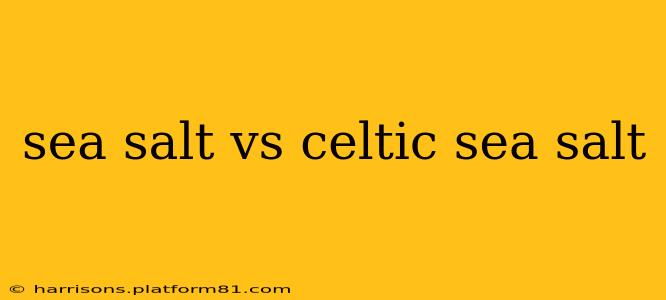Sea salt. The very words conjure images of sun-drenched beaches and the vast, untamed ocean. But within the seemingly simple world of sea salt lies a surprising diversity, with variations like Celtic sea salt often commanding a premium price. This article delves into the key differences between regular sea salt and Celtic sea salt, helping you make informed choices for your culinary and wellness needs.
What is Sea Salt?
Before we dive into the specifics of Celtic sea salt, let's establish a baseline understanding of sea salt in general. Sea salt is, quite simply, salt harvested from the ocean. The process involves evaporating seawater, leaving behind the salt crystals. However, the methods of evaporation and processing vary significantly, resulting in different textures, mineral compositions, and flavors. Some sea salts are minimally processed, retaining more of their natural minerals, while others undergo further refinement. This difference in processing is a key factor contributing to the distinctions between sea salt and Celtic sea salt.
What is Celtic Sea Salt?
Celtic sea salt distinguishes itself primarily through its harvesting and processing methods. It's traditionally harvested from the Guérande salt marshes of France and the Noirmoutier Island region. These unique salt marshes, with their blend of seawater and clay, impart a distinctive flavor and mineral content to the salt. The traditional methods involve allowing seawater to slowly evaporate in shallow basins, a process that takes several weeks or even months. This slow evaporation allows for a more complete crystallization process, resulting in larger, flaky crystals compared to many commercially produced sea salts.
What are the Key Differences Between Sea Salt and Celtic Sea Salt?
The differences between sea salt and Celtic sea salt are nuanced but significant:
-
Mineral Content: While all sea salts contain minerals, Celtic sea salt is often touted for its higher concentration of trace minerals, including magnesium, potassium, and calcium. These minerals contribute to its unique flavor profile and purported health benefits. However, the actual mineral content can vary depending on the specific source and harvesting method.
-
Flavor Profile: Celtic sea salt typically boasts a less intensely salty taste compared to some refined sea salts. It often features a more complex, nuanced flavor profile, described as subtly sweet and slightly earthy due to the minerals and clay present in the salt marshes.
-
Texture: The slow evaporation process in Celtic sea salt production often yields larger, flakier crystals, adding a visually appealing and texturally distinct element to dishes. This contrasts with the finer grains of many commercially processed sea salts.
-
Color: Celtic sea salt often displays a slightly gray or off-white hue due to the presence of minerals and clay, whereas refined sea salts tend to be a brighter white.
Does Celtic Sea Salt Have More Minerals Than Regular Sea Salt?
While Celtic sea salt often has a higher concentration of trace minerals than many refined sea salts, it's crucial to remember that the mineral content can vary. The exact mineral composition depends on several factors, including the specific location of the salt marshes, weather conditions, and harvesting techniques. It's not universally true that all Celtic sea salts contain significantly more minerals than all other sea salts.
Is Celtic Sea Salt Healthier Than Regular Sea Salt?
The claim that Celtic sea salt is "healthier" than regular sea salt is often made, but it requires careful consideration. The higher concentration of trace minerals in some Celtic sea salts may offer potential health benefits, but the overall health impact is negligible when compared to overall diet. Moderation in salt intake is key for overall health, regardless of the type of salt you use. Too much sodium, regardless of the source, can negatively impact blood pressure.
Which is Better for Cooking?
The best sea salt for cooking ultimately depends on personal preference and the specific dish. Celtic sea salt's larger flakes and complex flavor profile can be excellent for finishing dishes, enhancing the overall taste experience. Its coarser texture may not be ideal for baking where fine-grained salt is typically preferred. Conversely, fine-grained sea salts are suitable for everyday cooking and baking.
In conclusion, while both sea salt and Celtic sea salt originate from the ocean, their unique production methods result in distinct characteristics. The choice between them hinges on individual preferences for taste, texture, and potential mineral content. Remember that moderation in sodium intake is crucial for maintaining good health, irrespective of the salt variety.
